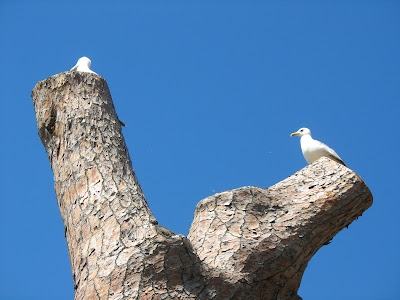
This is really the reason we were travelling. The 24th and 25th of May are the festival days of, respectively, Saint Sara and Saints Marie-Jacobe and Marie-Salome. Saint Sara is the handmaiden of Saints Marie-Jacobe and Marie-Salome, and is widely venerated by gypsies as 'the gypsy saint'. The cult of all three saints has centred on the town of Les Saintes-Maries-de-la-Mer, which is the capital of the Camargue. (The church in Les Saintes-Maries-de-la-Mer dates from 400BC, so there must, to be fair, have been religious reasons to like the place before the arrival of the saints). We were able to get the last room in the last hotel in town. The church is a weird building, 'l’église fortifiée', with thick walls and deep foundations and battlements and a spring of fresh water in the crypt. The Camargue used to be under regular attack from pirates.


The festival is organised around two processions. On the first day, the image of Sara is taken down to the beach, and then the two Maries are led into the sea and back on to dry land, to recreate their arrival two thousand years ago. In the evening between the two processions, the relics of the Maries are displayed in the church and people visit them.
Gypsies came from all over Europe, and scholars and tourists came from all over the world. Spanish gypsies:



Hungarian gypsies:

French gypsies:


Some people were obviously using the fact of being gypsies as a way to make some money:


But most people were just keen to participate, although it was at times unclear if this was because it was what was done, or what they wanted to do, or what they were moved to do.

The church was on constant mass duty.

The two processions were broadly similar, except for the fact that Saint Sara's was a little smaller. The image was taken from the church, preceded by a large amount of recognisable parish regalia:



The next day, people were more dressed up, usually in Arlesienne costume. The image of the two Maries was carried with an honour guard of horses to break a way through the crowd. There had been horses the day before, but not so many.




The image of the two Maries was accompanied by two small children.

We went slowly down to the sea, and then into the sea. And then slowly out of the sea, crowding in all the time.


And then the image was carried in great ceremony back to the church, to re-enter in triumph and be enthroned until next year.

And the town was empty again by the afternoon - a few slightly disconsolate accordionists trying to drum up some custom.

















































